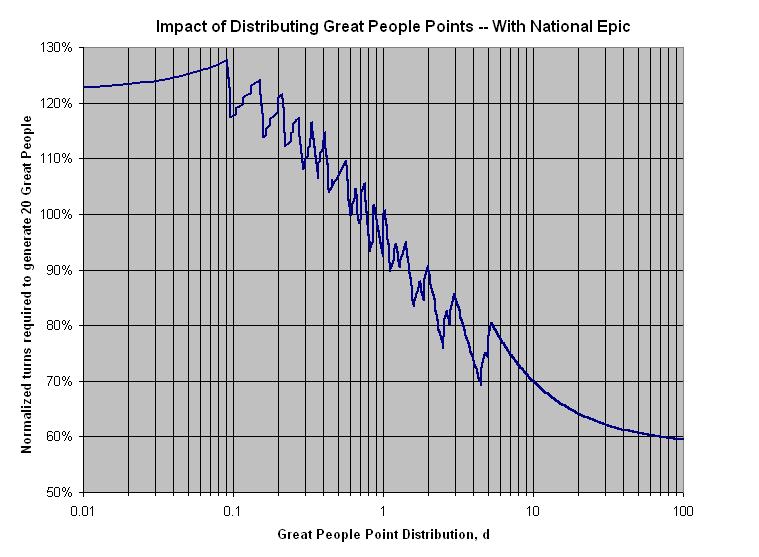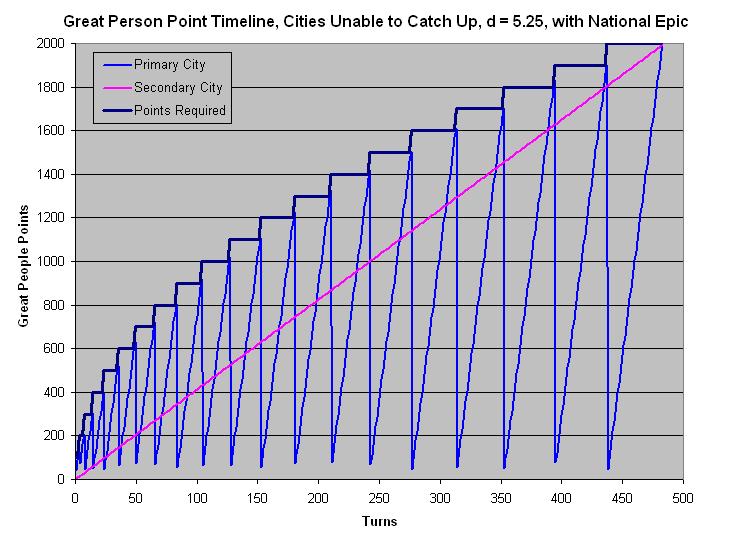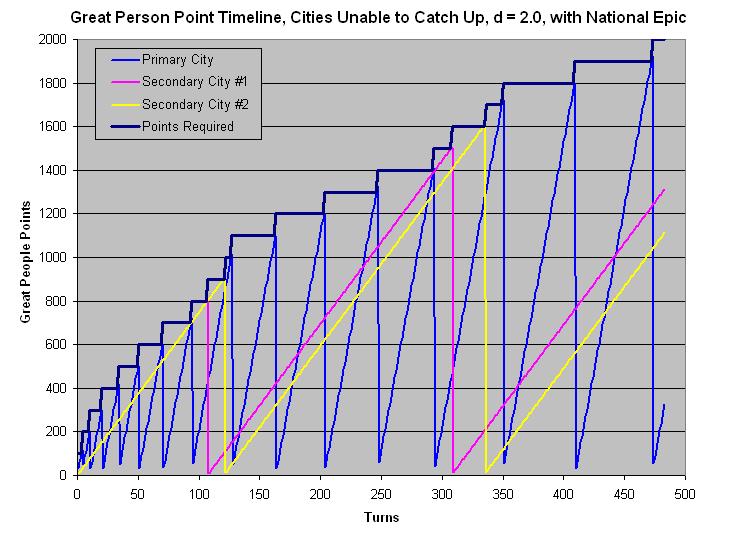While playing some recent games, I became curious about whether or not it mattered if I concentrated all of my Great People Point production in one city or not. Assume that you have a finite number of points you can generate across your empire, you can either focus all of them (specialists and wonders) in one city, or across a few cities (say your three best cities).
If the points required to generate a Great Person were constant (always 100), this would not be an issue. In the long run, the points would always generate the same number of great leaders. However, the points required is not constant. Each Great Person costs 100 more Great People points to generate than the last.
As I’m sure we’ve all seen, cities with a single specialist (+3 GPP/turn) steadily accumulate points, however the capital may be generating many Great People in the meantime, and thus raising the bar, faster than the smaller city can catch up. Basically, any city that cannot produce 100 Great People Points in the time it takes for the biggest cities to generate another Great Person will never produce one.
So I built a simple simulator, so I could explore the dynamics. These are the assumptions/parameters I used:
- Three cities, with a finite number of Great People Points distributed across them. For simplicity, I chose 30 Great People Points to distribute.
- I defined a parameter, d, which describes the distribution of those points. Basically, its the ratio of the the points in one city to the others.
For example:
If d = 1, the cities have 10, 10, 10.
If d = 2, the cities have 15, 7.5, 7.5.
If d = 3, the cities have 18, 6, 6.
If d = 10, the cities have 25, 2.5, 2.5.
As d approaches infinity, the cities have 30, 0, 0.
If d is larger, you have one city that has much more Great People Points production than the other cities.
If d = 0.5, the cities have 6, 12, 12.
If d = 0.1, the cities have 1.428, 14.28, 14.28.
As d approaches 0, the cities have 0, 15, 15.
If d is smaller, you have one city that has fewer Great People Points than the other cities.
– I ran the simulation and measured the number of turns required to generate 20 Great People, and then normalized the data about d = 1.
Here is the result:

Please note the use of a logarithmic x-axis, and the y-axis is zoomed in. Lower is better, as this denotes fewer turns required to generate the same number of Great People.
Some observations to make:
- No distribution of Great People Points can help you or harm you by more than about 8%.
- The sporadic behavior is caused by cases where cities are unable to “catch-up” to the increasing point total required to generate a Great Person.
- At around d < 0.2, the city with less Great People points is never able to generate a Great Person, as the required total number of points increases faster than the city can accumulate points. Thus, beyond this point, it is better to use those Great People Points to speed up the other cities.
- At round d > 10, the same thing happens in reverse. The other two cities are now never able to generate a Great Person since the primary city is outpacing them and moving the required total faster than they can generate points. At this point, it is better to focus on the one city.
- Both extremes approach asymptotic limits
- There is a dangerous break-point near d = 10 where the primary city gains one more Great People Point and now the required total points is outpacing the other cities, reducing Civ-wide Great People production by 16%.
This case assumed that there were no boosts to Great People Point production. Most boosts are empire-wide (Parthenon, Philosophical, Pacificist), and thus the d value is unchanged (all numbers get bigger, but the ratios stay the same, you have 60 points to distribute instead of 30).
However, the National Epic boosts Great People Points by 100% in just one city. Let’s see how that impacts the distribution of points:

We basically see the exact same behavior, but it has been “tilted” and moved to the left by 2x with the impact of the National Epic’s 100% multiplier.
Now we see some more interesting, and expected, behavior:
- The total difference in points (from having no Great People Points in the city with the National Epic, to having all Great People Points in a city with the National Epic) is a factor of 2 (60% to 120%).
- Individual break-points relating to cities being unable to catch up to the pace still has an effect of about 10%.
- Focusing all of your Great People Points in one city is the way to go
- The big jump-point where no other city can produce a Great Person due to the run-away primary city now occurs at d = 4. That is, the primary city is generating 20 points (40 with National Epic), and the other two cities are generating 5 points. It takes 2.5 turns to generate 100 points for the primary city, and 20 turns to generate 100 points for the other cities at that point.
In summary, in the reasonable range of d, there is a potential to increase your Great People production by 20% to 30% if you focus your Specialists and Wonders in one city with the National Epic. Other cities will be able to produce Great People, up until a point. If you get many Wonders and Specialists in your National Epic city, you may gain no Great People from having a single specialist or wonder in another city.
As with most other game systems in Civ4, its all about specialization. Having jack-of-all-trades cities is significantly less efficient.
A little more detail on cities trying to catch-up to a pace-setting primary city.
Here’s an example off of the National Epic curve, where d = 5.25 and within the scope of a game, the other cities are never able to generate a Great Person.

Now, the required number of points goes with the square root of turns, while the accumulated points for any city goes linearly with turns, so there is always some point in time where a city will generate a Great Person. Its just that with a sufficiently fast primary city, this point in time may exceed the 400 turn limit of the game.
Here’s an example of d = 2.0 (primary city has 15 points [30 with National Epic], the two secondary cities have 7.5 points).

Here we see that the secondary cities produce 4 Great People, and the primary city produces 16 Great People. Even this relatively slight difference in raw Great People Point production (15 vs. 7.5) has a large effect.
